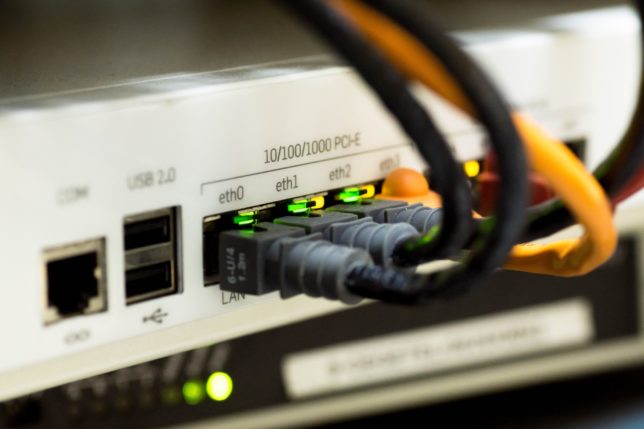
Comparing straight-through vs. crossover cables is fairly simple when you take the basics of the two. We’d like to break down these differences more granularly so that anyone can understand why these two cables need to be used in separate situations.
This article will cover the terms you need to know, what a straight-through cable is and what a crossover cable is. We will also go over comparing the two cable types, and when you should hire some help.
Networking for a business can be simple with a couple of hosts on a network. But once you begin adding servers, switches, backup devices, security devices, and much more, you may need to hire a professional.
Terms to Know
The primary terms we’ll go over are connectors, pins, hosts, and wires. For clarification, connectors will always cover the RJ45 connectors. You can find an RJ45 connector at most computer shops or local superstores.
Pins are the slots that are within the RJ45 connectors where wires can be placed and punched down to lock them in. Pins must be punched with the correct wire sequence to function correctly.
Hosts are any device on a network. This covers computers, routers, switches, hubs, and other devices. A host is any device type on a network that communicates with other devices on the network.
When wires are brought up, they will be the various wires that make up a cat5 cable. There are 8 different wires in a cat5 cable and they will all be connected in different sequences to accomplish each cable type.
What Is a Straight-Through Cable?
A straight-through cable is an ethernet cable that connects the wires within it one to one on both sides. This means that wire one will connect to pin spot one in both connectors, wire two will connect to pin spot two in both connectors, and so on.
The set of colored wires are configured in the order: orange-white, orange, green-white, blue, blue-white, green, brown-white, brown. They are ordered from the pin one slot to the pin eight slot.
The wires come from a cat5 cable and can be assigned in various patterns to achieve different results with the ethernet cable. These cables are always used to connect devices to each other.
A straight-through cable is also called a catch cable by some professionals. Straight-through cables are the most common ethernet cable that is used.
What Is a Crossover Cable?
A crossover cable is also an ethernet cable. The difference between a straight-through cable is that it has a different wire sequence between connectors.
With a crossover cable, the configuration of the wires is slightly more complicated. With an ethernet connector, there are 8 pin slots on each side of the cable.
The wires will be organized in this order: pin one on side A connects to pin three on side B, pin two on side A connects to pin six on side B, pin three on side A connects pin one on side B, pin four on side A connects to pin seven on side B, pin five on side A connects to pin eight on side B, pin six on side A connects to pin two on side B, pin seven on side A connects to pin four on side B, and pin eight on side A connects to pin five on side B.
There are also set, colored wires that go into each pin slot. With the pin connections woven this way, it creates a system where the wires are overlapping each other. A crossover cable also uses a cat5 cable.
The order of colors in order from pin one to pin eight would be, orange-white, orange, green-white, blue, blue-white, green, brown-white, brown. There are various diagrams online if you’d like to create your own ethernet cables after purchasing cat5 cable.
Straight-Through vs. Crossover Cables
Besides the configuration of the wires, there are a number of differences between the two. Comparing straight through vs. crossover cables is fairly straight forward, and configuring the connectors is typically the hardest part.
The general rule of thumb when it comes to comparing these two wiring types is that straight-through cables are used for dissimilar devices and crossover cables are used for similar devices.
Straight-through cables will be used to connect different types of hosts to each other. This means that whenever you are connecting a computer to a router, a router to a switch, and so on, you will have to use a straight-through cable for the hosts to communicate with each other.
A crossover cable covers the other situations where you are connecting the same device type to each other. This is used very commonly used to connect to computers to each other when wireless internet wasn’t as reliable. Or, if people didn’t want to rely on wireless internet to connect their computers together.
If you aren’t sure which wire you have, you can simply look at the connectors on each side of the cable and see if the colored wires are the same or crossed over. RJ45 connectors are seethrough, so you can always verify which type of cable you are working with.
If anything fails to work after connecting, luckily nothing horrible will happen. The only side effect to using the wrong cable type is that the hosts you are connecting won’t connect. At that point, simply try the other cable type and it will most likely work!
When Should You Hire a Professional?
Hiring an IT professional is never a bad idea. There are plenty of IT businesses that you can support to have continual or one-time support to fix a problem you’re stuck on.
Building a network from the ground up, ensuring your data is protected, and verifying that you have redundancy is extremely important. With the direction that technology has moved in the last couple of decades, it is almost a necessity to consult a professional for your IT business plan.
If you’re running into issues regarding cabling, such as cables not making connections, you will most likely want to reach out to a professional.
The pricing for these types of services can vary. Some businesses have a monthly subscription model, one-time charges, or yearly contracts that you can agree to. The vast majority of IT professionals are willing to discuss what fits best for your size of the business, and there are numerous articles going over costs.
Pricing for IT Professionals
Pricing can vary greatly depending on your area and how large your business is. There are most likely local resources to figure out what pricing may be. Calling around to businesses never hurts either. Most IT professionals are happy to discuss business with you!
In short, you will likely pay $50-$100 per hour of work plus the cost of hardware for a one-time job.
For monthly contracts with an IT professional, they will most likely bill per device that you have on your network. This can seem more expensive at first, but if something does break, you’ll typically save a lot of money. The cost you are looking at here is $50-$300 per-user or per-device.
Prices decrease with more users or devices, so the biggest contributor to the wide range is the volume of services you need. More people or more devices equals less cost per user or device.
If you agree to a yearly contract, you will likely get an even greater reduction. This is because you are committing to a longer time period of guaranteed money for the other business. In these cases, you’ll see between $30-$200 per user.
Regardless of your choice, hiring an IT professional can make things much simpler for you so you can focus on your business and not which wire goes where.
Keep It Simple
Knowing the difference between straight-through vs. crossover cables is the first step to understanding networking and how devices communicate.
If you take anything out of this article, it should be that straight-through cables are used for different device types and crossover cables are used for similar device types.
If you are ever over your head when it comes to technology, don’t be afraid to hire a professional. Some people might be genuinely interested in all of the technology out there, and for those people, we would encourage you to read some of our other articles!
Our goal is to help businesses be successful and navigate the complexities of the modern-day business. If you need help, feel free to contact us anytime and anywhere. We are here to help!
Total Technology Solutions For Your Business
Our services are engineered to meet the specific objectives of each client. That starts with having the right people, who are experts in their field to develop solutions that support our clients.
Thoughtful solutions, not quick fixes.


